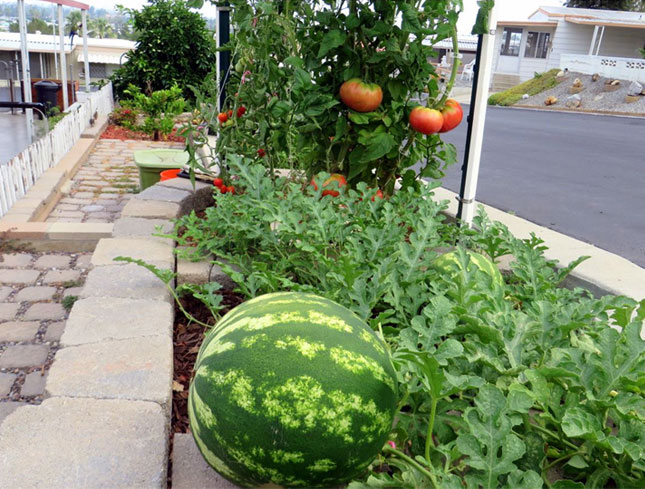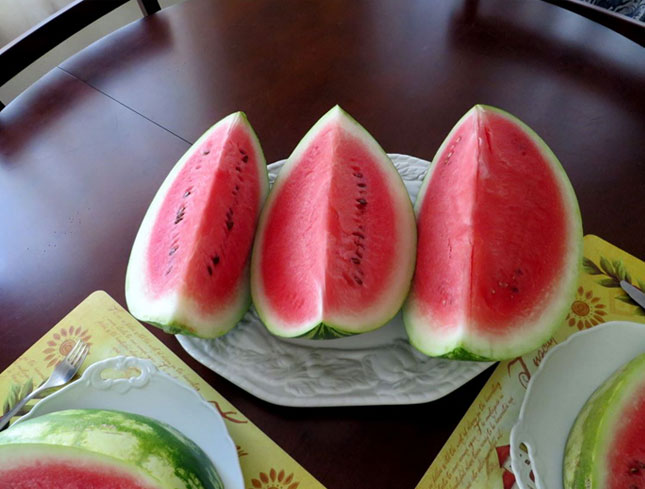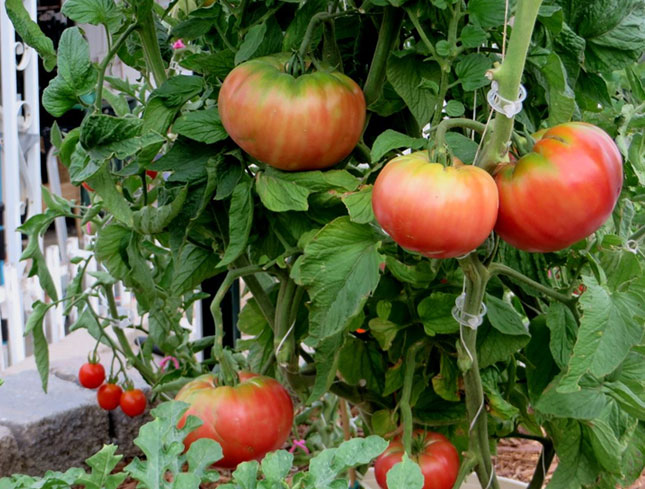Growing watermelons in a water saving way
April 1st, 2015
The tap water in the city of Hemet, California, is extracted from local wells. Therefore, the water is very hard and full of minerals. Not very suited for urban farming. From his experience, Bill McNeese knows that this causes a thick white crust in for example water hose attachments, which results in quickly clogged holes and pores. Therefore, he wasn’t surprised when the wicks in the Waterboxx® plant cocoons completely stopped working in about 90 days.
However, the good news was that the tomatoes and melons grew so fast, that by the time the wicks clogged, the plants were able to find their own water and kept growing and producing. Urban farming could continue. During the urban farming experiments with the Waterboxx® plant cocoon, there was very little precipitation. It wasn’t enough to make a difference. Additionally, Bill started with nursery transplants, so the taproots never grew as deeply as they otherwise would have done. However, with the help of the Waterboxx® plant cocoon and the mycorrhizae that were used, the plants found enough water to survive.
Growing watermelons in the Waterboxx® plant cocoon
The statistics of the watermelons that were growing in the Groasis Waterboxx® plant cocoon on April 1st, 2015, were very good. The day before Bill started to plant with the Waterboxx plant cocoon, he added 10 gallons of water (38 liters) to the soil. During the plantation, he added 4 gallons of water (15 liters) at the water reservoir of the Waterboxx® plant cocoon. After the plantation, Bill added six times 1 gallon (almost 4 liters) of extra water to the plants.


Bill used one Waterboxx® plant cocoon with three wicks (which he added by himself) and two plants (Crimson Sweet). On July 19, he had 5 organically grown melons with a total weight of 68 lbs (31 kg). The largest melon was 22 lb (10 kg) and the smallest melon was 8.6 lb (4 kg). The average weight of the melons was 13.6 lb (6,2 kg).
Tips for growing watermelons in your garden
Do you want to start growing watermelons in your garden with the Waterboxx® plant cocoon? Read the tips of Bill McNeese below:
- Always use new wicks when you are going to plant again! When replanting, throw away the old wicks and put in new ones to ensure the longest lifetime;
- If you want to grow vegetables, one wick is not enough. Two or three wicks per Waterboxx® plant cocoon is perfect for any vegetable in any climate. For vegetables in very hot and dry climates, it might be advantageous to start with three wicks. This will facilitate the start of the root development. The only time you should use four wicks, is when growing giant pumpkins;
- If you used mycorrhizae and your wicks degrade in 60 till 90 days, the roots of your plants are probably big enough to find water on their own, just like the plants of Bill McNeese. In case of doubt, water can be poured in the center hole of the Waterboxx® plant cocoon;
- When planting, use mycorrhizae and a good organic fertilizer such as Nature Safe. Bill uses sometimes certain amendments like worm castings as well. However, you should not overdo it. Bill forgot to add fertilizer to a box this year, so it only got mycorrhizae, and his tomatoes did just fine;
- If you prune your plants, and the fruits are fully exposed to the intense sun and heat, they can develop sun scald. In order prevent this, you can use a shade cloth with 30% light blockage;
- If you know the plants will grow big, place just one plant per box. Bill McNeese learned through his experience that even though the plants produce well with two plants per box, pruning can be more difficult (see picture below).

Optimal use of a long growing season
In areas with a long growing season, like California, a well-tended and healthy tomato plant can keep growing and producing for 7 months or longer (consider the Stupice and Juliet varieties). In that time, a plant may have used most of the available nutrients in just two, three of four months. In that case, Bill would consider feeding the plant with compost tea, seaweed or fish emulsion combo, poured directly in the center of the Waterboxx® plant cocoon.
Bill McNeese did not add additional water to the boxes since June 22nd, 2015. It has rained one week (about 2 inches), which was very positive for the growth of the plants. Also, the only (organic) fertilizer gives was at the planting. In total, Bill has harvested 114 ripe fruits from his Juliet tomato plant. The plant shows no sign of slowing down. Look like it might produce another 200 fruits!















